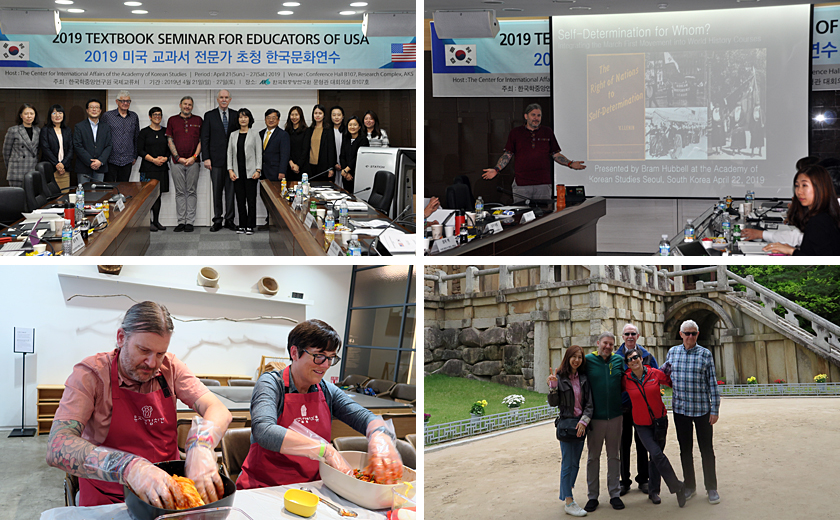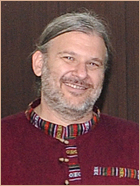Column
2019 Textbook Seminar for Educators of USA
Self-Determination for Whom: Integrating the March First Movement and Korean History into World History Courses
Too often "new topics" in world history courses simply get appended to existing narratives. There are new sections at the end of a textbook chapter that offer a counterpoint or the boxed text in the middle of the chapter. When I was invited to participate in the Textbook Seminar for Educators of the United States, I wanted to highlight one of the ways in which I'm both reshaping the stories we tell in world history courses and integrating Korean history into world historical narratives. While I was at the Academy of Korean Studies’ Fellowship for American Educators in April 2019, I presented a short discussion about how we can reframe the end of World War I (the Great War), so that we focus less on how the failures of the Paris Peace Conference contributed to World War II and focus more on how Wilson's "Fourteen Points" speech and how global events of 1919 highlight the emergence of a global anticolonial movement in which Koreans played an important role.
Like many students around the world, I can recall first learning about Woodrow Wilson's 1918 "Fourteen Points" speech, and the phrase "too idealistic" stuck in my mind. Wilson's calls for increased diplomacy, free trade, demilitarization, and self-determination were all good ideas, but they simply wouldn't be accepted by the British and French. While there is definitely truth to the idea of the British and French opposing Wilson's ideas, the "idealistic" epithet dismisses the way in which colonized peoples all over the world read about Wilson's support for self-determination and responded by developing national it independence movements calling for independent participation in the Paris Peace Conference and various degree of home rule and independence from colonial control.
In my presentation, I drew on the arguments of Erez Manela in his The Wilsonian Moment: Self-Determination and the International Origins of Anticolonial Nationalism, which I supplemented with a number of classroom-friendly short textual and visual primary sources. Manela shows how the rhetoric of self-determination was already known around the world before 1918, but was often associated with more radical individuals such as Vladimir Lenin. After Wilson used the language of self-determination and his speech began to circulate around the world, colonized peoples began to make use of Wilson's ideas in their own push for representation.
In the classroom, I begin by showing the cover of Lenin's “The Right of Nations to Self-Determination,” which was published in 1914, and the text of Point 5 from Wilson's speech. After students discuss what self-determination means, students consider why the British and French would oppose this idea. I then have students focus on six different examples of colonized peoples making use of the idea of self-determination: the Irish Home Rule movement and their petition for representation at the Paris Peace Conference, Nguyen Ai Quoc/Ho Chi Minh's attempt to represent the Vietnamese people at Paris, the Indian Home Rule League's "Self-Determination for India," Saad Zaghloul's attempt to represent the Egyptians at Paris and the subsequent 1919 Egyptian Uprising, the Korean March First Movement, and the Chinese May Fourth Movement. With each nationalist movement, students look at a short textual primary source or a visual source that highlights the way in which different colonized peoples channeled the ideas of Wilson and Self-Determination.
After students talk about the different case studies, we discuss as a class how these case studies were connected and how they challenge the older, more Eurocentric interpretation of the aftermath of the Great War. Students begin to see how self-determination went from being seen as a relatively fringe and radial idea to being an idea supported around the globe as well the interconnected nature of anticolonial movements. And in the case of the work of the Academy of Korean Studies, this lesson also highlights Koreans as being fully integrated into a more global world historical narrative and as having historical agency.
I would like to thank Dahee Kim and the rest of the Academy of Korean Studies for inviting me to participate in the fellowship for educators and hosting me during my week in Korea.
Like many students around the world, I can recall first learning about Woodrow Wilson's 1918 "Fourteen Points" speech, and the phrase "too idealistic" stuck in my mind. Wilson's calls for increased diplomacy, free trade, demilitarization, and self-determination were all good ideas, but they simply wouldn't be accepted by the British and French. While there is definitely truth to the idea of the British and French opposing Wilson's ideas, the "idealistic" epithet dismisses the way in which colonized peoples all over the world read about Wilson's support for self-determination and responded by developing national it independence movements calling for independent participation in the Paris Peace Conference and various degree of home rule and independence from colonial control.
In my presentation, I drew on the arguments of Erez Manela in his The Wilsonian Moment: Self-Determination and the International Origins of Anticolonial Nationalism, which I supplemented with a number of classroom-friendly short textual and visual primary sources. Manela shows how the rhetoric of self-determination was already known around the world before 1918, but was often associated with more radical individuals such as Vladimir Lenin. After Wilson used the language of self-determination and his speech began to circulate around the world, colonized peoples began to make use of Wilson's ideas in their own push for representation.
In the classroom, I begin by showing the cover of Lenin's “The Right of Nations to Self-Determination,” which was published in 1914, and the text of Point 5 from Wilson's speech. After students discuss what self-determination means, students consider why the British and French would oppose this idea. I then have students focus on six different examples of colonized peoples making use of the idea of self-determination: the Irish Home Rule movement and their petition for representation at the Paris Peace Conference, Nguyen Ai Quoc/Ho Chi Minh's attempt to represent the Vietnamese people at Paris, the Indian Home Rule League's "Self-Determination for India," Saad Zaghloul's attempt to represent the Egyptians at Paris and the subsequent 1919 Egyptian Uprising, the Korean March First Movement, and the Chinese May Fourth Movement. With each nationalist movement, students look at a short textual primary source or a visual source that highlights the way in which different colonized peoples channeled the ideas of Wilson and Self-Determination.
After students talk about the different case studies, we discuss as a class how these case studies were connected and how they challenge the older, more Eurocentric interpretation of the aftermath of the Great War. Students begin to see how self-determination went from being seen as a relatively fringe and radial idea to being an idea supported around the globe as well the interconnected nature of anticolonial movements. And in the case of the work of the Academy of Korean Studies, this lesson also highlights Koreans as being fully integrated into a more global world historical narrative and as having historical agency.
I would like to thank Dahee Kim and the rest of the Academy of Korean Studies for inviting me to participate in the fellowship for educators and hosting me during my week in Korea.



